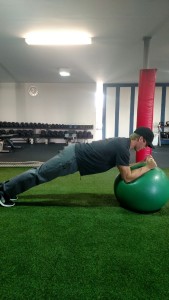By Brett Holland, PT, DPT, CSCS
“Proximal stability for distal mobility” is a common phrase used by athletic trainers, strength and conditioning coaches, and physical therapists. What it is referring to is the ability of the core to keep your proximal segments (trunk, hips) stabile, while allowing your extremities (arms, legs) to produce movement. “Core” exercises are a hot topic right now. Before we discuss improving your core let us define what is “core stability”.
Core stability is a combination of:
- core strength
- core endurance
- appropriate timing (your core strength doesn’t matter if you are activating it late)
- neuromuscular control (the nervous system and musculoskeletal systems ability to communicate and produce a response to movement or external force)
- core stiffness
Core stiffness!? How could stiffness be better for you, I thought doing stretches and exercises through full range of motion is better?
Dr. Stuart McGill, a leader in resolving and preventing back pain, has summarized why a stiffer core is beneficial for you[1]:
- “stiffening the torso proximal to the shoulders and hips transfers the full force and movement of muscles to the distal side of these ball and socket joints resulting in greater limb strength and speed”
- “muscularly stiffening the spinal column enhances its load bearing capacity preventing buckling”
- ” the muscular turgor associated with stiffness creates an armor over vital structures enhancing resilience during contact sports”
The problem with many core exercises:
- They produce too much load on potential injury sites
- They are repetitive and can lead to degeneration over time
- To clarify, Dr. McGill states” many of these exercises violate mechanisms found to cause injury to the spine and subject the spine to high shear and compressive loads “[1].
What makes isometric based core exercises so good?
- They are able to effectively activate the core while minimizing imposed spinal loads [1].
- They improve passive stiffness. Passive stiffness is simply when your muscles are not contracting, like when you bend over to pick a pen up. Think of passive stiffness as a warning sign, it limits you before you reach a point where you can injure tissues.
- Isometric training can enhance core activation. Isometric training has been shown to improve maximal voluntary contraction [2].
I already do heavy squats and deadlifts and they have been shown to activate the core, why do I need to train the core separately?
- First, these are not isometric exercises and will not improve core stiffness to the same degree.
- Secondly, they only train the core in one plane (sagittal). You neglect both the frontal and transverse planes (think of sideways and rotation).
- Dr. McGill sums it up extremely well, “Many athletic tasks involve stability about the frontal and transverse planes; consider a football player who sprints 5 yards forward and powerfully cuts left. If lateral core stiffness is insufficient, energy leaks causing buckling at the torso compromises speed and increases known injury mechanisms of spine bending under load (28) and knee valgus buckling (20). In essence, when sufficient core stiffness is lacking, athlete movement becomes inefficient and manifested by performance decrements and increased injury risk” [1].
What are some good isometric exercises?
Sagittal Plane:
- Brief case hold/Farmers walk (farmers walk is dynamic in the sense your legs move but isometric in the sense your core is held in a constant contraction) weights in both hands
- Pank (all sorts of variations, weighted vests, unstable surfaces)
- Anterior/posterior pallof press
- Bird-dog
Frontal Plane
- side plank (again any variation)
- Unilateral farmer walk or brief case hold
Transverse Plane
- Rotational pallof hold
- Wood chop hold
References
- Lee, Benjamin C. Y., and Stuart M. Mcgill. “Effect of Long-term Isometric Training on Core/Torso Stiffness.” Journal of Strength and Conditioning Research 29.6 (2015): 1515-526. NSCA.
- Garfinkel S, Cafarelli E. Relative changes in maximal force, EMG, and muscle cross-sectional area after isometric training. Med Sci Sports Exerc 24: 1220–1223, 1992.

